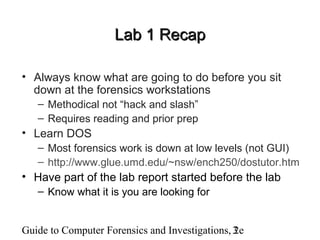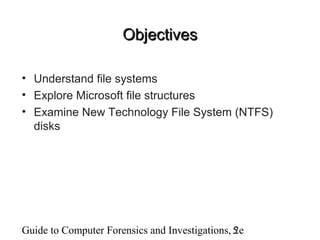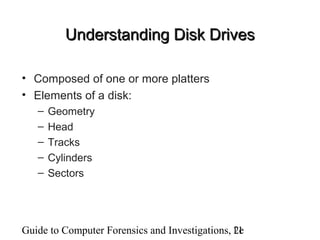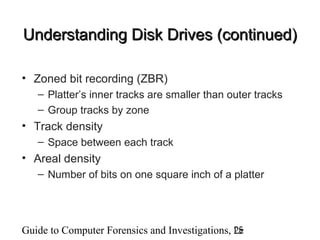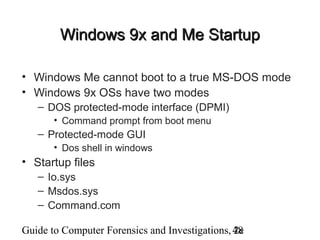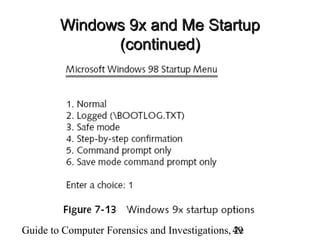Cos413day3
- 2. Guide to Computer Forensics and Investigations, 2e2 AgendaAgenda • Questions? • Assignment 1 due • Lab Write-ups (project 2-1 and 2-2) due next class • Lab Recap and After Action Report • Begin Discussion on Working with Windows and DOS Systems – Chapter 3 in 1e and Chapter 7 in 2e
- 3. Guide to Computer Forensics and Investigations, 2e3 Lab 1 RecapLab 1 Recap • Always know what are going to do before you sit down at the forensics workstations – Methodical not “hack and slash” – Requires reading and prior prep • Learn DOS – Most forensics work is down at low levels (not GUI) – http://www.glue.umd.edu/~nsw/ench250/dostutor.htm • Have part of the lab report started before the lab – Know what it is you are looking for
- 4. Guide to ComputerGuide to Computer Forensics andForensics and InvestigationsInvestigations Chapter 3 Working with Windows and DOS Systems
- 5. Guide to Computer Forensics and Investigations, 2e5 ObjectivesObjectives • Understand file systems • Explore Microsoft file structures • Examine New Technology File System (NTFS) disks
- 6. Guide to Computer Forensics and Investigations, 2e6 Objectives (continued)Objectives (continued) • Understand the Windows Registry • Understand Microsoft boot tasks • Understand MS-DOS startup tasks
- 7. Guide to Computer Forensics and Investigations, 2e7 Understanding File SystemsUnderstanding File Systems • Understand how OSs work and store files • CompTIA A+ certification • File system – Road map to data on a disk – Determines how data is stored on disk • Become familiar with file systems
- 8. Guide to Computer Forensics and Investigations, 2e8 Understanding the Boot SequenceUnderstanding the Boot Sequence • Avoid data contamination or modification • Complementary Metal Oxide Semiconductor (CMOS) – Stores system configuration, data, and time • BIOS – Performs input/output at hardware level
- 9. Guide to Computer Forensics and Investigations, 2e9 Understanding the Boot SequenceUnderstanding the Boot Sequence (continued)(continued) • Make sure computer boots from a floppy disk – Modify CMOS – Accessing CMOS depends on the BIOS • Delete key • Ctrl+Alt+Insert • Ctrl+A • Ctrl+F1 • F2 • F12
- 10. Guide to Computer Forensics and Investigations, 2e10 Understanding the Boot SequenceUnderstanding the Boot Sequence (continued)(continued)
- 11. Guide to Computer Forensics and Investigations, 2e11 Understanding Disk DrivesUnderstanding Disk Drives • Composed of one or more platters • Elements of a disk: – Geometry – Head – Tracks – Cylinders – Sectors
- 12. Guide to Computer Forensics and Investigations, 2e12 Understanding Disk Drives (continued)Understanding Disk Drives (continued)
- 13. Guide to Computer Forensics and Investigations, 2e13 Understanding Disk Drives (continued)Understanding Disk Drives (continued) • Cylinder, head, sector (CHS) calculation – 512 bytes per sector – Tracks contain sectors – Number of bytes on a disk • Cylinders (platters) x Heads (tracks) x sectors • First track is track 0 – So if a disc list 79 tracks (like a floppy) does, it has 80 tracks
- 14. Guide to Computer Forensics and Investigations, 2e14
- 15. Guide to Computer Forensics and Investigations, 2e15 Understanding Disk Drives (continued)Understanding Disk Drives (continued) • Zoned bit recording (ZBR) – Platter’s inner tracks are smaller than outer tracks – Group tracks by zone • Track density – Space between each track • Areal density – Number of bits on one square inch of a platter
- 16. Guide to Computer Forensics and Investigations, 2e16 Exploring Microsoft File StructuresExploring Microsoft File Structures • Need to understand – FAT – NTFS • Sectors are grouped on clusters – Storage allocation units of at least 512 bytes – Minimize read and write overhead • Clusters are referred to as logical addresses • Sectors are referred to as physical addresses
- 17. Guide to Computer Forensics and Investigations, 2e17 Disk PartitionsDisk Partitions • Logical drive • Hidden partitions or voids – Large, unused gaps between partitions – Also known as partition gaps – Can hide data • Use a disk editor to change partitions table – Norton Disk Edit – WinHex, Hex Workshop – http://www.x-ways.net/winhex/index-m.html
- 18. Guide to Computer Forensics and Investigations, 2e18 Disk Partitions (continued)Disk Partitions (continued)
- 19. Guide to Computer Forensics and Investigations, 2e19 Disk Partitions (continued)Disk Partitions (continued) • Disk editor additional functions – Identify OS on an unknown disk – Identify file types
- 20. Guide to Computer Forensics and Investigations, 2e20 Disk Partitions (continued)Disk Partitions (continued)
- 21. Guide to Computer Forensics and Investigations, 2e21
- 22. Guide to Computer Forensics and Investigations, 2e22 Disk Partitions (continued)Disk Partitions (continued)
- 23. Guide to Computer Forensics and Investigations, 2e23
- 24. Guide to Computer Forensics and Investigations, 2e24 Master Boot RecordMaster Boot Record • Stores information about partitions – Location – Size – Others • Software can replace master boot record (MBR) – PartitionMagic – LILO – Can interfere with forensics tasks – Use more than one tool
- 25. Guide to Computer Forensics and Investigations, 2e25 Examining FAT DisksExamining FAT Disks • FAT was originally developed for floppy disks – Filenames, directory names, date and time stamps, starting cluster, attributes • Typically written to the outermost track • Evolution – FAT12 – FAT16 – FAT32
- 26. Guide to Computer Forensics and Investigations, 2e26 Examining FAT Disks (continued)Examining FAT Disks (continued)
- 27. Guide to Computer Forensics and Investigations, 2e27 Examining FAT Disks (continued)Examining FAT Disks (continued) • Drive slack – Unused space on a cluster – RAM slack • Can contain logon IDs and passwords • Common on older systems – File slack • Bytes not used on the sector by the file • FAT16 unintentionally reduced fragmentation
- 28. Guide to Computer Forensics and Investigations, 2e28 Examining FAT Disks (continued)Examining FAT Disks (continued)
- 29. Guide to Computer Forensics and Investigations, 2e29 Examining FAT Disks (continued)Examining FAT Disks (continued) • Cluster chaining – File clusters are together (when possible) • Produces fragmentation • Tools – Norton DiskEdit – DriveSpy’s Chain Fat Entry (CFE) command • Rebuilding broken chains can be difficult
- 30. Guide to Computer Forensics and Investigations, 2e30 Examining FAT Disks (continued)Examining FAT Disks (continued)
- 31. Guide to Computer Forensics and Investigations, 2e31
- 32. Guide to Computer Forensics and Investigations, 2e32 Deleting FAT FilesDeleting FAT Files • Filename in FAT database starts with HEX E5 • FAT chain for that file is set to zero • Free disk space is incremented • Actual data remains on disk • Can be recovered with computer forensics tools
- 33. Guide to Computer Forensics and Investigations, 2e33 Examining NTFS DisksExamining NTFS Disks • First introduced with Windows NT • Spin off HPFS – From IBM O/S 2 • Provides improvements over FAT file systems – Stores more information about a file • Microsoft’s move toward a journaling file system – Keep track of transactions – Can be rolled back
- 34. Guide to Computer Forensics and Investigations, 2e34 Examining NTFS Disks (continued)Examining NTFS Disks (continued) • Partition Boot Sector starts at sector 0 • Master File Table (MFT) – First file on disk – Contains information about all files on disk (meta-data) • Reduces slack space • NTFS uses Unicode – UTF-8, UTF-16, UTF-32
- 35. Guide to Computer Forensics and Investigations, 2e35 Examining NTFS Disks (continued)Examining NTFS Disks (continued)
- 36. Guide to Computer Forensics and Investigations, 2e36 NTFS File AttributesNTFS File Attributes • All files and folders have attributes • Resident attributes – Stored in the MFT • Nonresident attributes – Everything that can be stored on the MFT • Uses inodes for nonresident attributes • Logical and virtual cluster numbers – LCN and VCN
- 37. Guide to Computer Forensics and Investigations, 2e37 NTFS Data StreamsNTFS Data Streams • Data can be appended to a file when examining a disk – Can obscure valuable evidentiary data • Additional data attribute of a file • Allow files be associated with different applications
- 38. Guide to Computer Forensics and Investigations, 2e38 NTFS Compressed FilesNTFS Compressed Files • Improve data storage – Compression similar to FAT DriveSpace 3 • File, folders, or an entire volume can be compressed • Transparent when working with Windows XP, 2000, or NT • Need to decompress it when analyzing – Advanced tools do it automatically
- 39. Guide to Computer Forensics and Investigations, 2e39 NTFS Encrypted File System (EFS)NTFS Encrypted File System (EFS) • Introduced with Windows 2000 • Implements a public key/private key encryption method • Recovery certificate – Recovery mechanisms in case of a problem • Works for local workstations or remote servers
- 40. Guide to Computer Forensics and Investigations, 2e40 Deleting NTFS FilesDeleting NTFS Files • Similar to FAT • NTFS is more efficient than FAT – Reclaiming deleted space – Deleted files are overwritten more quickly
- 41. Guide to Computer Forensics and Investigations, 2e41 Understanding the Windows RegistryUnderstanding the Windows Registry • Database that stores: – Hardware and software configuration – User preferences (user names and passwords) – Setup information • Use Regedit command for Windows 9x • Use Regedt32 command for Windows XP and 2000 • FTK Registry Viewer
- 42. Guide to Computer Forensics and Investigations, 2e42 Understanding the Windows RegistryUnderstanding the Windows Registry (continued)(continued) • Windows 9x Registry – User.dat – System.dat • Windows 2000 and XP Registry – WinntSystem32Config – WindowsSystem32Config – System, SAM, Security, Software, and NTUser.dat
- 43. Guide to Computer Forensics and Investigations, 2e43 Understanding the Windows RegistryUnderstanding the Windows Registry (continued)(continued)
- 44. Guide to Computer Forensics and Investigations, 2e44 Understanding Microsoft Boot TasksUnderstanding Microsoft Boot Tasks • Prevent damaging digital evidence • OSs alter files when computer starts up
- 45. Guide to Computer Forensics and Investigations, 2e45 Windows XP, 2000 and NT StartupWindows XP, 2000 and NT Startup • Steps: – Power-on self test (POST) – Initial startup – Boot loader – Hardware detection and configuration – Kernel loading – User logon
- 46. Guide to Computer Forensics and Investigations, 2e46 Startup Files for Windows XPStartup Files for Windows XP • Files used during boot process: – NTLDR – Boot.ini – BootSec.dos – NTDetect.com – NTBootdd.sys – Ntoskrnl.exe – Hal.dll – Device drivers
- 47. Guide to Computer Forensics and Investigations, 2e47 Windows XP System FilesWindows XP System Files
- 48. Guide to Computer Forensics and Investigations, 2e48 Windows 9x and Me StartupWindows 9x and Me Startup • Windows Me cannot boot to a true MS-DOS mode • Windows 9x OSs have two modes – DOS protected-mode interface (DPMI) • Command prompt from boot menu – Protected-mode GUI • Dos shell in windows • Startup files – Io.sys – Msdos.sys – Command.com
- 49. Guide to Computer Forensics and Investigations, 2e49 Windows 9x and Me StartupWindows 9x and Me Startup (continued)(continued)
- 50. Guide to Computer Forensics and Investigations, 2e50 Understanding MS-DOS Startup TaskUnderstanding MS-DOS Startup Task • Io.sys – Loaded after the ROM bootstrap – Finds the disk drive – Provides basic input/output services • Msdos.sys – Loaded after Io.sys – Actual kernel for MS-DOS – Looks for Config.sys
- 51. Guide to Computer Forensics and Investigations, 2e51 Understanding MS-DOS Startup TaskUnderstanding MS-DOS Startup Task (continued)(continued) • Msdos.sys (continued) – Loads Command.com – Loads Autoexec.bat • Config.sys – Commands run only at system startup • Autoexec.bat – Customized setting for MS-DOS – Define default path and environmental variables
- 52. Guide to Computer Forensics and Investigations, 2e52 Other Disk Operating SystemsOther Disk Operating Systems • Control Program for Microprocessors (CP/M) • Digital Research Operating System (DR-DOS) • Personal Computer Disk Operating System (PC- DOS) – Developed by IBM
- 53. Guide to Computer Forensics and Investigations, 2e53 DOS Commands and Batch FilesDOS Commands and Batch Files • Batch files – Fixed sequence of DOS commands – Ideal for repetitive tasks • Batch files work like a single command • MS-DOS supports parameter passing and conditional execution – Can pass up to 10 parameters
- 54. Guide to Computer Forensics and Investigations, 2e54 DOS Commands and Batch FilesDOS Commands and Batch Files (continued)(continued)
- 55. Guide to Computer Forensics and Investigations, 2e55 DOS Commands and Batch FilesDOS Commands and Batch Files (continued)(continued)
- 56. Guide to Computer Forensics and Investigations, 2e56 SummarySummary • FAT – FAT12, FAT16, and FAT32 • Windows Registry keeps hardware and software configuration and preferences • CHS calculation • NTFS • Look for hidden information on file, RAM, and drive slack
- 57. Guide to Computer Forensics and Investigations, 2e57 Summary (continued)Summary (continued) • NTFS uses Unicode to store information • Hexadecimal codes identify OSs and file types • NTFS uses inodes to link file attribute records – Resident and nonresident • NTFS compressed files • NTFS encrypted files (EFS)



